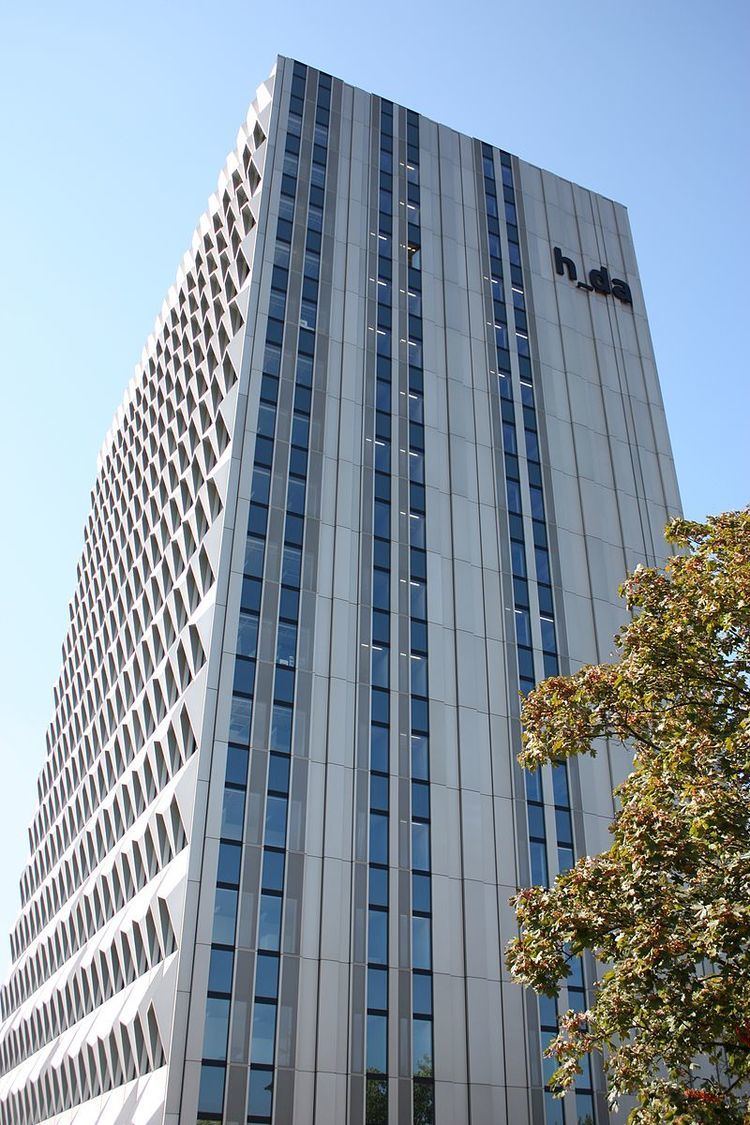Type Public university Administrative staff 815 (2010) Phone +49 6151 1602 | President Ralph Stengler Students 11,380 (2010) Total enrollment 15,058 (2014) Founded 1 August 1971 | |
 | ||
Similar Technische Universität Darmstadt, RheinMain University of Applie, Frankfurt University of Applie, University of Applied Sciences, Evangelische Hochschule Darmstadt Profiles | ||
The Darmstadt University of Applied Sciences (German: Hochschule Darmstadt), also known as h_da, is a University of Applied Sciences located in Darmstadt, Germany. It is internationally known for its outstanding achievements in the areas of engineering and computer science. Also, the selection criteria for this university are the toughest among the universities of applied sciences in Germany. The University has the highest number of industrial linkage programs, compared to the rest of the universities of applied sciences.
Contents
- History
- Outcomes and Revolution in education system of Germany
- Campus
- Departments
- Admission Procedure into Engineering Disciplines
- University of Applied Sciences Ranking
- Research
- Industrial Linkages
- International Presence
- Prominent Partner Institutes
- Notable Research Projects in Faculty of Electrical Engineering
- Institutes
- References
History
The roots of University of Applied Sciences Darmstadt goes back to1876 along with Technische Universität Darmstadt(the first electrical engineering chair and inventions fame), when both these Universities were an integrated entities, a need for a separate industry based research educational institution was felt in early 1930s, finally University of Applied sciences emerged as a separate industry based research educational institution in 1971 and is the largest University of Applied Sciences in Hesse (German: Hessen) with about 11,000 students.
Outcomes and Revolution in education system of Germany
In 1971 when Hochschule Darmstadt was established, other regions of the Hesse also felt the need of such industry based educational institutions. In later years a heavy number of Hochschule were established all across Germany. As a result of this,today the German industry's engineering workforce is propelled by students of the Hochschule.
Campus
The Main campus of the Hochschule Darmstadt lies at the Haardtring office, but, the campus is evenly distributed all across the city of Darmstadt at different locations. A cluster of Old and Modern university buildings are visible across the city of Darmstadt. The media campus is in Dieburg.
Departments
Admission Procedure into Engineering Disciplines
The competition amongst the foreign as well as EU nationals for admission into Hochschule Darmstadt is quite high. There are a number of alternative admission criterion available for the students. The prospective students have to match any of the following criterion
The above are true only in case of certain programs and is not a generic requirement.
University of Applied Sciences Ranking
Hochschule Darmstadt is a reputed institute and it has consistently ranked high on the DAAD rankings list closely rivaled by Hochschule Karlsruhe. Maintaining its reputation in the specializations of Microelectronics and Robotics, Hochschule Darmstadt has contributed to some of the major industrial developments in Germany, including REIS, Mitsubishi Robot modules.
Research
Incorporated close ties with
Industrial Linkages
International Presence
h_da boasts international exchange students drawn from more than 100 institutions abroad and is a leading producer of talent for high-tech firms.
Prominent Partner Institutes
Notable Research Projects in Faculty of Electrical Engineering
Projekte im Fachbereich Elektrotechnik und Informationstechnik
* IP-Qualität Prof. Dr.-Ing. Johannes Gerdes * Entwicklung von mikroprozessorgesteuerten Regelschaltungen für organische Leuchtdioden Prof. Dr.-Ing. Johannes Gerdes * Multiprozessorsystem zur massiv-parallelen digitalen Echtzeitkorrelation von optischen Messdaten auf Basis von STERA SPARTAN FPGAs Prof. Dr. Bernhard Hoppe Prof. Dr. Hermann Meuth * Integrierte CMOS Bildsensorik Prof. Dr. Bernhard Hoppe * JAVA Virtual Machine ASIC mit on-chip Multi Media Hardware Prof. Dr. Bernhard Hoppe * Sensorennetzwerk aus bildgebenden Sensoren mit kinematischen Feiheitsgraden (proof of concept) Prof. Dr.-Ing. Karl Kleinmann * Messsystem zur Ermittlung der Artefaktempfindlichkeit von Elektroden zur Ableitung elektrophysiologischer Signale bei mechnanischen Störungen Prof. Dr.-Ing. Klaus-Peter Koch * Netztraining im liberalisierten Strommarkt Prof. Dr.-Ing. Dieter Metz * Netztraining und effizienter Netzbetrieb Prof. Dr.-Ing. Dieter Metz * Integrierte Funktionsgeneratoren für die digitale Synthese von hoch präzisen periodischen Signalen Prof. Dr. Hermann Meuth * Piezomotor-Ansteuerung für Avionik, Bionik und Robotik Prof. Dr. Hermann Meuth * Erprobung der Regelungsstruktur Prof. Dr. Hermann Meuth * Entwicklung eines MAXIMUMWÄCHTERS auf PC/SPS Prof. Dr. August Reiner * 2MN-Module für die multimediale netzbasierte HochschullehreELAT (ENVIRONMENT FOR LEARNING AND TEACHING) Prof. Dr. Horst Röder * Adaptives Regelungsverfahren für Robotergelenke mit nichtsteifem Getriebe Prof. Dr. Klaus Schaefer, Prof. Dr. Wolfgang Weber Prof. Dr. Dietrich Weber (M), Prof. Dr. Jürgen Wiese * Brennstoffzelle als Energieversorgung für Rollstühle Prof. Dr.-Ing. Heinz Schmidt-Walter * Rekonfigurierbares digitales Filter für Audio/Videosignalverarbeitung Prof. Dr.-Ing. Thomas Schumann * Ermittlung von Winkelgeschwindigkeiten Prof. Dr.-Ing. Wolfgang Weber * PPI-Kaskade-Antriebsregler Prof. Dr.-Ing. Wolfgang Weber * MinZy: Minimierung der Zykluszeit für modellbasierte Roboterregelungen Prof. Dr.-Ing. Wolfgang Weber * Reis-Steuerung RS 5 Prof. Dr.-Ing. Wolfgang Weber * Erprobung der Regelungsstruktur Prof. Dr.-Ing. Wolfgang Weber * RoboGet: Adaptives Regelungsverfahren für Robotergelenke mit nichtsteifem Getriebe Prof. Dr.-Ing. Wolfgang Weber * Abtriebsregelung Prof. Dr.-Ing. Wolfgang Weber * ReDuS+ Anwenderorientierter Entwurf abtriebsseitiger Gelenkregelungen Prof. Dr.-Ing. Wolfgang Weber * Hochdynamische, bidlgestützte Regelung von Industrierobotern für die Nahtverfolgung an flexiblen Objekten (HYBRINO) Prof. Dr.-Ing. Alexandra Weigl-Seitz * Hochfrequenzbeatmung von Frühgeborenen Prof. Dr. Jürgen Wiese